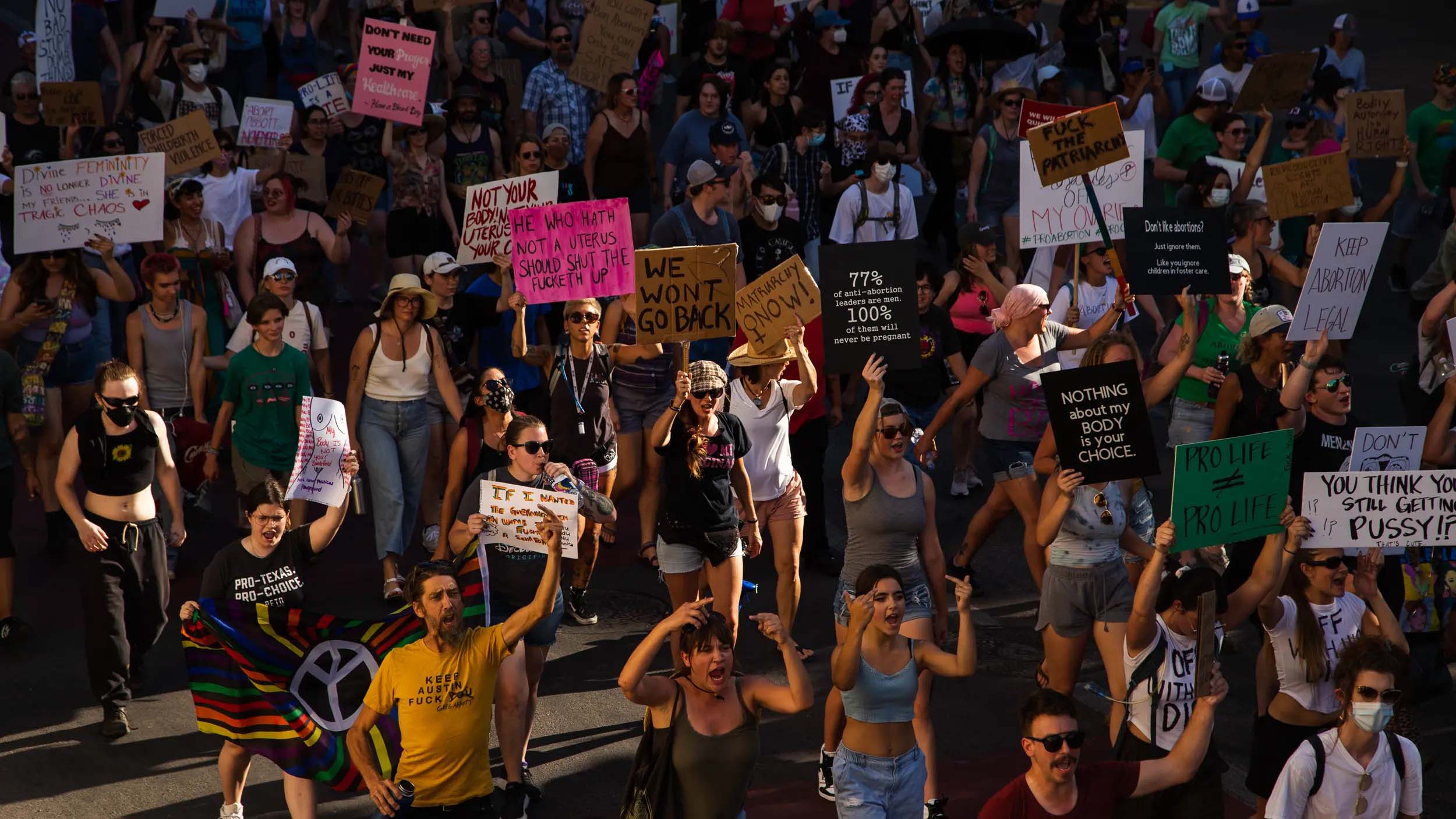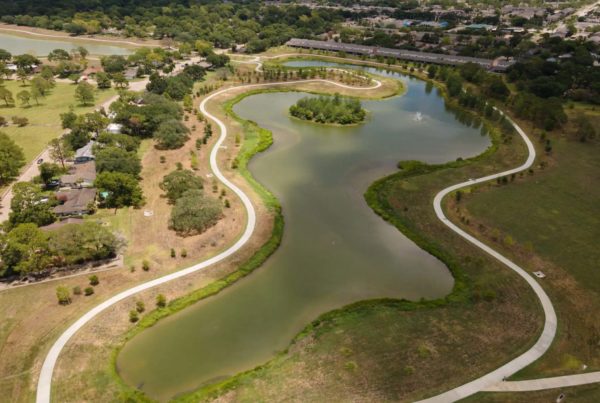From The Texas Tribune:
Editor’s note: This story contains some graphic descriptions of abortions.
When Mollie Smith learned she was pregnant by her former school teacher, the 20-year-old was “mentally depressed and despondent.” She asked the man who impregnated her to help her seek an abortion.
It was 1897. Options were limited in the rural region of Texas where she lived, along the Red River that would, two decades later, come to form the Oklahoma state line. So Smith’s former teacher got a blacksmith to make a “metallic instrument,” which he used to open her vagina to allow him to insert a 7-inch metal rod inside of her womb.
“She stated that this operation gave her pain, and that for a short time she felt sick and faint, but it soon passed off,” according to court records. Smith also drank a compound of cotton root and oil of rue, and a month later, delivered a stillborn fetus.
At the time, Texas was under a near-total abortion ban that outlawed performing or “furnishing the means for” an abortion, except to save the life of the pregnant patient, punishable by up to five years in the penitentiary.
The law had been on the books for as long as Texas had books, dating back to the creation of the state’s penal code in 1857. It remained in effect, largely unchanged but only intermittently enforced, for the next 116 years until the U.S. Supreme Court ruled it unconstitutional in the Roe v. Wade decision in 1973.
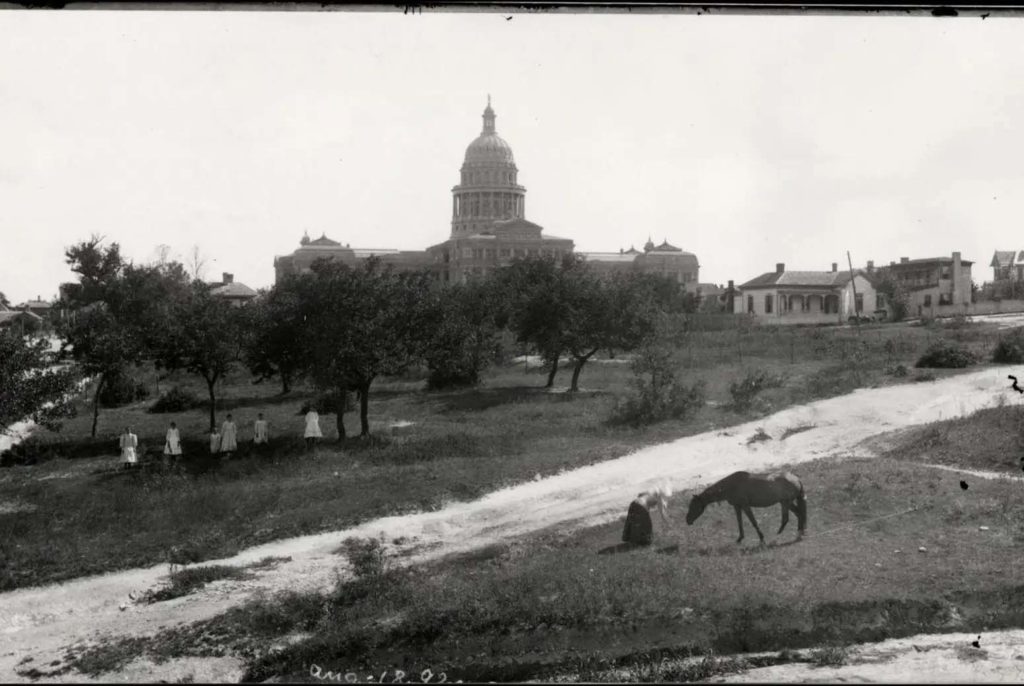
The north side of the Texas Capitol grounds in 1892.
Now, after a reversal from the same court at the end of June, this frontier-era statute is once again the law of the land, leading to a near-total termination of abortion in Texas. Clinics have closed, and citing the vagueness of the law, abortion funds have even stopped paying for the procedure over state lines — state lines which, in some cases, didn’t even exist when the law was first written.
The laws, often called the “pre-Roe statutes,” are also sometimes mistermed the “1925 laws,” which refers to the year that Texas recodified the statute while reorganizing its penal code.
But the laws actually appeared much earlier, during the brief period when Texas had joined the United States but not yet left for the Confederacy. It was a moment when many states were passing similar restrictions, motivated by a declining white birth rate and encouraged by a nascent medical profession trying to take control of childbirth and reproduction.
How these 165-year-old statutes that have been suspended for five decades will be used in 2022 remains to be seen, said South Texas College of Law professor Charles “Rocky” Rhodes.
“This was legislation that wasn’t really designed for the types of situations that we’re being presented with today,” he said. “It’s just not very clear … to try to figure out what they meant back then.”
Spanish origins
The origin of abortion restrictions in Texas starts much earlier — and in a much different place — than much of the rest of the country.
British common law, which governed the early United States, allowed abortion up to “quickening” or the point 15 to 20 weeks into pregnancy when a fetus can first be felt moving in the womb.
But Texas originated as a Spanish colony and then became part of independent Mexico, both of which prohibited abortion. For its decade of existence, the Republic of Texas “just continued on with that,” said Lina-Maria Murillo, a historian at the University of Iowa who has studied abortion laws in Texas and Mexico.
“Texas is special … because it experiences so many different legal systems in a matter of decades,” Murillo said. “And the abortion question really brings into stark relief that moment of turmoil of Texas and its position vis a vis the United States.”
Despite the longstanding legal restrictions on abortion, Texans still found ways to control their reproductive destinies, historians say. In the absence of pregnancy tests or advanced understanding of menstrual cycles, how these practices aligned with the abortion law wasn’t always clear-cut.
“There were no period trackers at the time, and so they would take a potion or a brew, and they would take it to so-called ‘bring on their menses,’” said reproductive health historian Rebecca Kluchin. “It could be to regulate their menstruation or it could be to terminate a pregnancy … it was just really blurry.”
Abortion providers were rarely, if ever, criminalized in this period, in part because the information about whether and how long a woman was pregnant rested entirely with the woman herself.
“You can see cases where someone swears an abortion [happened] on a woman,” Kluchin said. “And … her representative — because she can’t speak in court — would just say she was never pregnant, and never quickened, and very clearly she’s not now, and the law finds for her.”
By the time Texas joined the United States in 1846, though, the former British colonies were moving in the direction of their Spanish counterparts when it came to criminalizing abortion.
Texas’ fledgling medical industry
Texas’ abortion statute, filed in the state’s first penal code under “offences against the persons or individuals,” came with two to five years of prison time for performing or furnishing the means for an abortion. The law exempted abortions performed “by medical advice” to save the life of the pregnant patient.
It was codified at a moment when the medical establishment in Texas was starting to take shape and assert itself politically.
In 1852, a group of physicians placed an ad in the Texas State Gazette calling a meeting of all those “desirous of promoting the advancement and improvement, as well as elevating the standard of our profession within this State.”
At the time, the medical profession in the United States was almost entirely unregulated. Any man — with any level of education or experience — could call himself a doctor and charge for medical remedies of varying usefulness. Texas had no medical schools, although several prominent Texans were educated in other states before returning home.
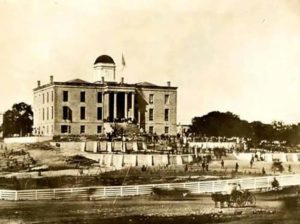
The Capitol building in Austin from 1856 until it burned in 1881.
Thirty-five of those trained physicians — referred to as the “regulars” — attended that first meeting in Austin in 1852 and, by the next year, succeeded in getting the Legislature to authorize the creation of the Medical Association of Texas.
They were all men; Texas would not admit the first “lady applicant” until 1887. And with the Civil War looming, according to a history of the Texas Medical Association, “practically all Texas physicians were loyal to the Confederacy.”
The nascent group wanted to institute educational requirements and standards of care to root out “quack” doctors. They also wanted to start making real money. Doctors were generally paid by the case, and since they weren’t particularly well-respected, they weren’t called on that often.
“But women were having babies every two years,” Kluchin said. “So doctors are trying to push in on midwives, in terms of childbirth, but midwives also tended to be the healers in their communities.”
Nationally, doctors started a campaign against midwives, Kluchin said, painting them as dirty, uneducated and dangerous to pregnant women.
“But these are health care providers who have a ton of knowledge and deep experience, and they tend to have better outcomes in terms of obstetrics than doctors,” Kluchin said. “Doctors come in in the 1850s with forceps and anesthesia promising an easier birth, but there’s no regulations.”
Midwives were also the keepers of knowledge about how to terminate a pregnancy. This is part of why state laws regulating abortion often had an exception to save the life of the pregnant patient — as determined by a doctor.
Texas’ efforts to regulate both childbirth and abortion coincided with a national effort started by a Boston doctor named Horatio Storer. Storer and the American Medical Association pushed states to tighten their abortion laws, citing concerns over “unborn life” and women shirking their responsibilities as wives and mothers, said Mary Ziegler, a legal historian focusing on abortion at Florida State University College of Law.
Storer’s other main argument — both explicit and implicit — focused on rising immigration and declining white birth rates. Birth rates in the U.S. plummeted during the 19th century from about seven children per woman to less than four, with white women making up the steepest declines.
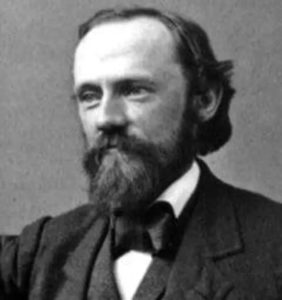
Texas’ efforts to regulate both childbirth and abortion coincided with a national effort started by a Boston doctor named Horatio Storer, who pushed states to tighten their abortion laws.
“The thought was that with the abortion laws as they stood, the racial stock of the U.S. was going to decline,” Ziegler said. “Because the wrong people were going to be having more kids and the right people were going to be having fewer kids.”
In Texas, a slave state with a large Mexican population, these racial concerns were front and center. Murillo posits that maintaining white birth rates was seen at that time as an essential part of maintaining white power in the state.
“They’re sort of wrestling with this population question at this moment,” Murillo said. “And it becomes even more so once they become part of the Confederacy in 1861, just [four] years after they established the penal code.”
Early legal battles
Unlike in current times, Texas’ 1850s abortion ban didn’t spark much of a backlash.
“People just kept having abortions,” Ziegler said. “To the extent there was a protest, it was just people ignoring the law.”
Texas was still largely rural and law enforcement was informal and sparse. There wasn’t much effort to proactively identify and root out people who were performing or helping people access abortions.
“These laws weren’t so much preventative as they were disciplinary,” Murillo said. “This is about making an example, especially an example of white women and … disciplining white fertility.”
The laws were most often used in cases in which the women died, like a case from the early 1900s near Fort Worth. Two doctors were called to treat a woman who was “suffering from hemorrhages from the womb which was greatly distended, the discharged matter being quite offensive,” according to court records.
Amid her screams of pain, the woman admitted that she’d had an abortion. The doctors refused to treat her until she told them who had helped her terminate her pregnancy. Eventually, she gave the name of a doctor who had “used instruments and tried to take it away.”
The doctor who elicited this deathbed confession told law enforcement that “he did not think she was dying at the time, and he further said that her cries were caused by the pain she was suffering rather than from any calm, deliberate belief that death was impending.”
The doctor she accused was convicted, though an appeals court later overturned the ruling on several grounds, including the inadmissibility of her dying declaration.
Court cases like these were the venue through which the nuances of the law were sorted out over the course of decades. In 1907, after that case and other legal challenges, the Legislature voted to add a definition of abortion to the law, declaring that the “fact that Article 641 of the Penal Code, which relates to the offense of abortion, does not define said offense, and is therefore inoperative, creates an emergency.”
In several cases from the turn of the century, the court ruled conclusively that the person who undergoes an abortion cannot be criminally charged as either the principal or accomplice.
An appeals court ruled that while Mollie Smith, the 20-year-old impregnated by her former teacher, “may be culpable morally, under our law she is not indictable for an abortion committed on herself.”
Smith’s case offers a foreshadow of how the law may be prosecuted in the modern era of medication abortion; the man who provided her with medication to terminate the pregnancy tried to argue in court that he was just an accomplice to her misconduct.
“Appellant seems to think, because he merely procured the drug, handed it to her and advised her to take it, and did not actually assist her or force her to take it, therefore he did not ‘administer’ it to her,” the appeals court wrote. “There is good authority sustaining the proposition that to deliver a drug, poison or medicine to another for the purpose of being used for abortion is to administer the same.”
1857 statutes today
At times, illegal abortion operated in plain sight in Texas, largely unchecked — and sometimes even aided — by law enforcement, Murillo said. But at other points, she said, the crackdowns would be swift and severe.
“It’s sort of ebbed and flowed with the politics of moralizing,” Murillo said.
But in the 1960s, the tide started moving in the opposite direction. Feminist activists, in Texas and across the country, began speaking out against abortion bans that had, in many cases, sat unexamined for decades. In 1970, two young women lawyers brought a lawsuit challenging the Texas statutes on constitutional grounds, and in 1973, the U.S. Supreme Court agreed with them.
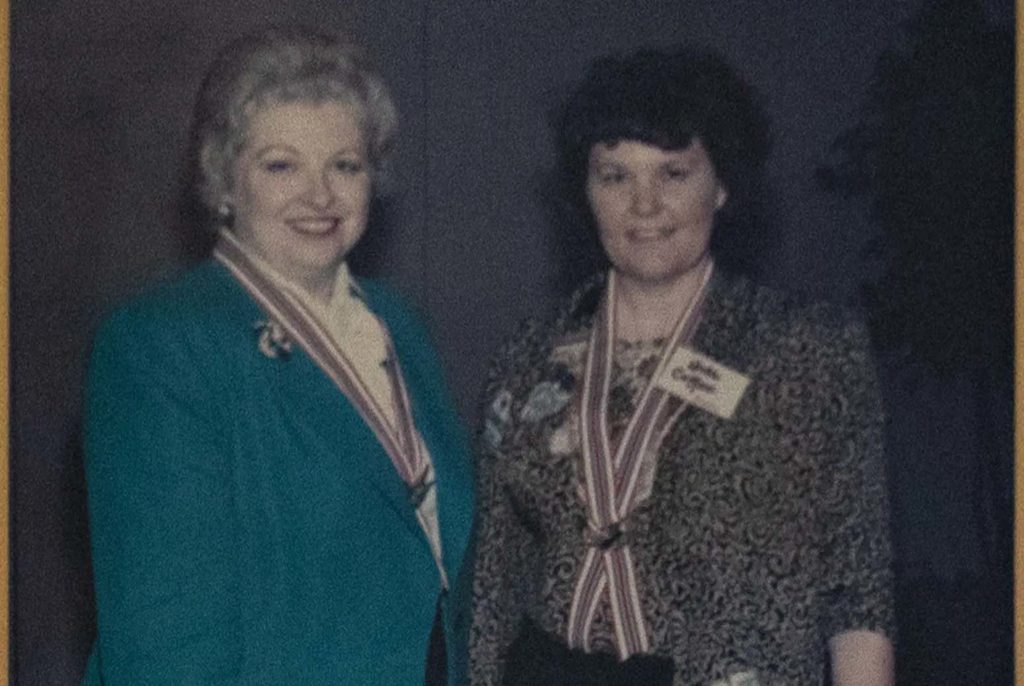
Lawyers Sarah Weddington and Linda Coffee worked together to successfully argue Roe v. Wade, which in 1973 gave women a right to abortion.
Roe v. Wade blocked not just Texas’ statute but all state abortion bans, instead instituting a constitutional protection for abortion up to the point of viability, usually around 22 to 24 weeks of pregnancy.
The Texas attorney general said in a 1974 advisory that the laws “are no longer of any effect. … Therefore, there are now no laws in this State regulating abortion, per se.” In 2004, the 5th U.S. Circuit Court of Appeals wrote that the laws had “at least, been repealed by implication.”
Unable to be enforced, the laws were, effectively, moot and were even moved out of the criminal code, into the civil statutes, when the state codified a new penal code in 1973. But they were never formally repealed, and in 2021, with the overturning of Roe v. Wade looming, the Texas Legislature started laying the groundwork to bring these zombie statutes back from the dead.
At the same time, lawmakers prepared for a more modern post-Roe future by passing a trigger law to automatically set in place an abortion ban 30 days after the U.S. Supreme Court issued its judgment overturning Roe v. Wade. That law explicitly protects a pregnant person from prosecution and allows for abortions in narrow cases to save the life of the pregnant patient. Unlike the 1857 law, it does not criminalize anyone who assists in or furnishes the means for a prohibited abortion.
But in late June, when the high court ruled on abortion, Attorney General Ken Paxton immediately issued an advisory, saying “abortion providers could be criminally liable for providing abortions starting today” under the pre-Roe statutes.
Clinics stopped providing abortions, and nonprofits that fund abortions stopped paying for procedures out of state, fearful that the law’s reference to “furnishing the means” for an abortion could be used against them.
A group of abortion clinics attempted to challenge the law in court, and even got a Houston judge to agree that they were no longer in effect.
But the Texas Supreme Court disagreed, meaning these laws — created on the eve of the Civil War, in the days of quack doctors and blacksmith implements — are again governing abortion access in modern-day Texas, at least for now.
Until the state Supreme Court says otherwise, these laws will remain in effect even when the trigger law goes into effect Aug. 25, creating a murky legal landscape that will likely have to be sorted out in court.
In the five decades that these laws have been unenforceable, abortion has emerged as a central political hatchet, dividing the country along party and state lines. Now, the country has split in two, with some states promising to protect abortion access as aggressively as others promise to stop it entirely.
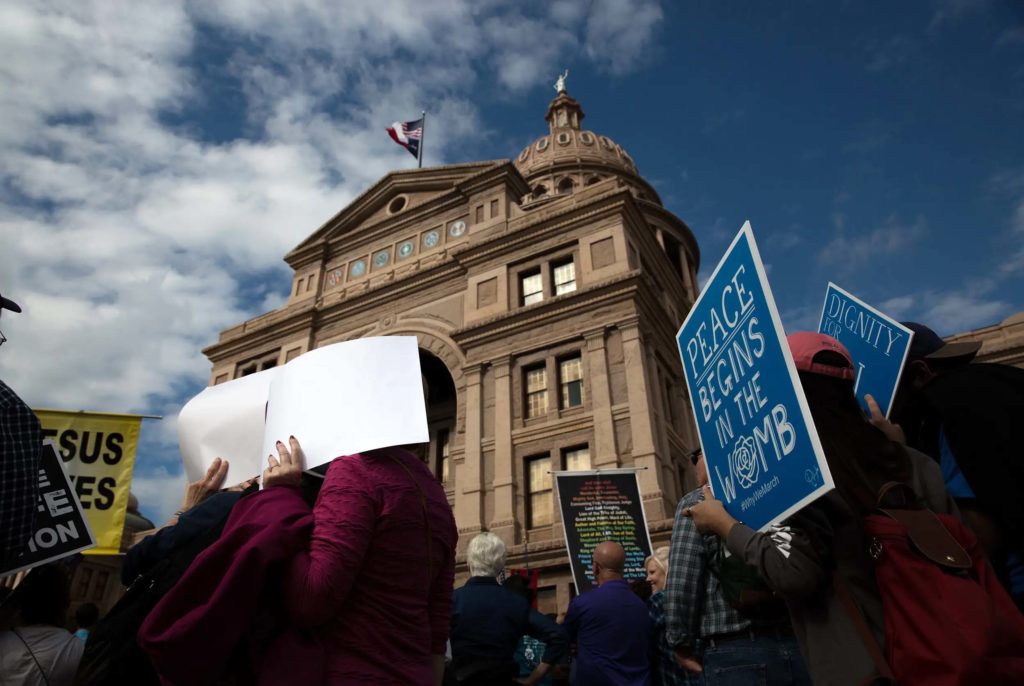
Abortion opponents attend the Rally for Life march at the Capitol in Austin on Jan. 27, 2018.
Texas’ most virulent anti-abortion lawmakers have made it clear that they intend to try to stop any Texan from getting an abortion anywhere in the country. The Freedom Caucus, made up of conservative state House members, has sent cease-and-desist letters to top law firms and abortion funds, threatening them with legal action if they help people leave the state to get abortions.
It’s not yet clear how and whether they will actually be able to criminalize out-of-state abortions, said Rhodes, the law professor. The answers to these — and many other — legal questions swirling around Texas’ abortion laws lie on the other side of a test case, which is not a risk most people are willing to take.
“They’re hoping that they’re going to be able to keep most of these questions from ever being resolved by courts by just having people comply,” Rhodes said. “Because they’re scared of the risk of what occurs if they don’t comply.”
To find a recent example of a time when politicians wanted to see such morally divisive state laws enforced in other states that were politically opposed to them, Rhodes said, you have to look back to the same era when these abortion laws were first written — when slave states were pushing the federal government to pass the Fugitive Slave Act and other legislation to enforce slavery laws in free states.
“There are parallels,” Rhodes said. “We’re dealing with these questions of extraterritorial application of state laws that we just haven’t really dealt with on this kind of systematic level in a long time in the United States.”
Disclosure: Texas Medical Association has been a financial supporter of The Texas Tribune, a nonprofit, nonpartisan news organization that is funded in part by donations from members, foundations and corporate sponsors. Financial supporters play no role in the Tribune’s journalism. Find a complete list of them here.


